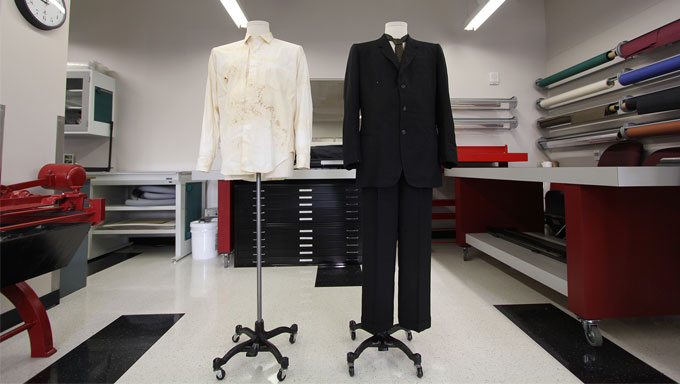
Next month marks the fiftieth anniversary of President John F. Kennedy’s assassination in Dallas, and to commemorate the tragic event, the Texas State Library and Archives Commission announced it will display an assassination exhibit that will include the bloody clothing worn by then-Texas Governor John Connally. Connally was shot while sitting in front of Kennedy during the assassination. At Parkland Memorial Hospital, where the president was declared dead, emergency room doctors removed the governor’s clothing during their efforts to save his life.
Connally survived, and, while recuperating in the hospital, he donated his bloody clothes to the state archives. Next Tuesday, October 22, marks the first time in fifty years the public will be able to see them. The exhibit will also include a photograph showing Lee Harvey Oswald’s escape route from the Book Depository, the Dallas Police Department’s inventory of items confiscated from Oswald, and Texas Attorney General Waggoner Carr’s 1964 report to the Warren Commission.
Despite the long passage of time, the evidence remains in good condition. The bullet holes are clearly visible, as are the bloodstains from Connally’s shirt. (The Washington Post published half a dozen pictures of the display.) Sarah Norris, the conservator for the Commission, said the exhibit, “makes it real. You can read about it and you can think about it, but to actually be in the room with it certainly gives you pause.”
The exhibit is sure to draw a good number of gawkers. Half a century after the assassination, the American public remains fascinated by both the tragedy of losing a young and charismatic leader and the innumerable conspiracy theories involving LBJ, the CIA, the KGB, the mafia, Fidel Castro, or some combination of them all.
Dallas city leaders have long prepared for the scrutiny the city and Dealey Plaza will come under next month. They have worked for well over a year, planning memorials that honor the late president while showing the world, which once dubbed Dallas “City of Hate,” how much it has changed since 1963. It’s been a struggle to strike the balance, something Mimi Swartz chronicled for Texas Monthly last November.
Connally served two terms as governor before becoming Secretary of the Treasury under Richard Nixon. In 1980, Connally unsuccessfully ran for the Republican nomination for president. He died in 1993. After Jacqueline Kennedy died the next year, Connally’s wife, Nellie, became the only living passenger from the Kennedy limousine. In 2003, she shared her memories of that day:
“We were indeed a happy foursome that beautiful morning,” she wrote. They were all in their thirties and forties, ready to take on the world: the handsome young president, who promised the dawn of a new era; the governor, fresh from his role as Secretary of the Navy, who had been in office for only ten months; Jackie, glamorous and, to Nellie, a little intimidating, dressed in a pink Chanel suit and carrying a bouquet of red roses; and Nellie, also dressed in pink, carrying yellow roses. She’d been fretting for days that her suit would clash with the first lady’s, that the Governor’s Mansion wouldn’t measure up to the sophisticated first couple’s scrutiny, and that, in general, the Kennedys would find Texas lacking. The warm response in Dallas, then, was an enormous relief. “John and I were just smiling with genuine pleasure that everything was so perfect,” Nellie wrote. Suddenly, “a terrifying noise erupted behind us.” From her spot on a jump seat, she turned back to look at the president just in time to see his hands fly up to his throat. Then, Nellie turned back to meet her husband’s eyes. John Connally had fought in World War II and was a hunter; he knew that sound had come from a gun, but it was too late. A second shot rang out, and Connally uttered what has become one of the most remembered lines of that day. “My God,” he cried, his rich, stentorian drawl taut with fear, “They’re going to kill us all!” Then he collapsed. The second bullet had hit him in the back.
Connally’s wounds contributed to the assassination conspiracy mythos. In their investigation, the Warren Commission determined the first bullet that struck Kennedy was the same one that hit Connally. Conspiracy believers scoff at their conclusion, calling it the “Magic Bullet Theory.” According to a 2003 Gallup poll, 75 percent of Americans believed there was a conspiracy to kill the president. In April, an AP-GfK survey found conspiracy support waning, although a majority of Americans still believed multiple people were involved in the assassination. Given the statistics, it’s a near certainty that the exhibit will draw amateur sleuths taking notes and pictures in hopes of finally cracking America’s greatest “mystery.”





